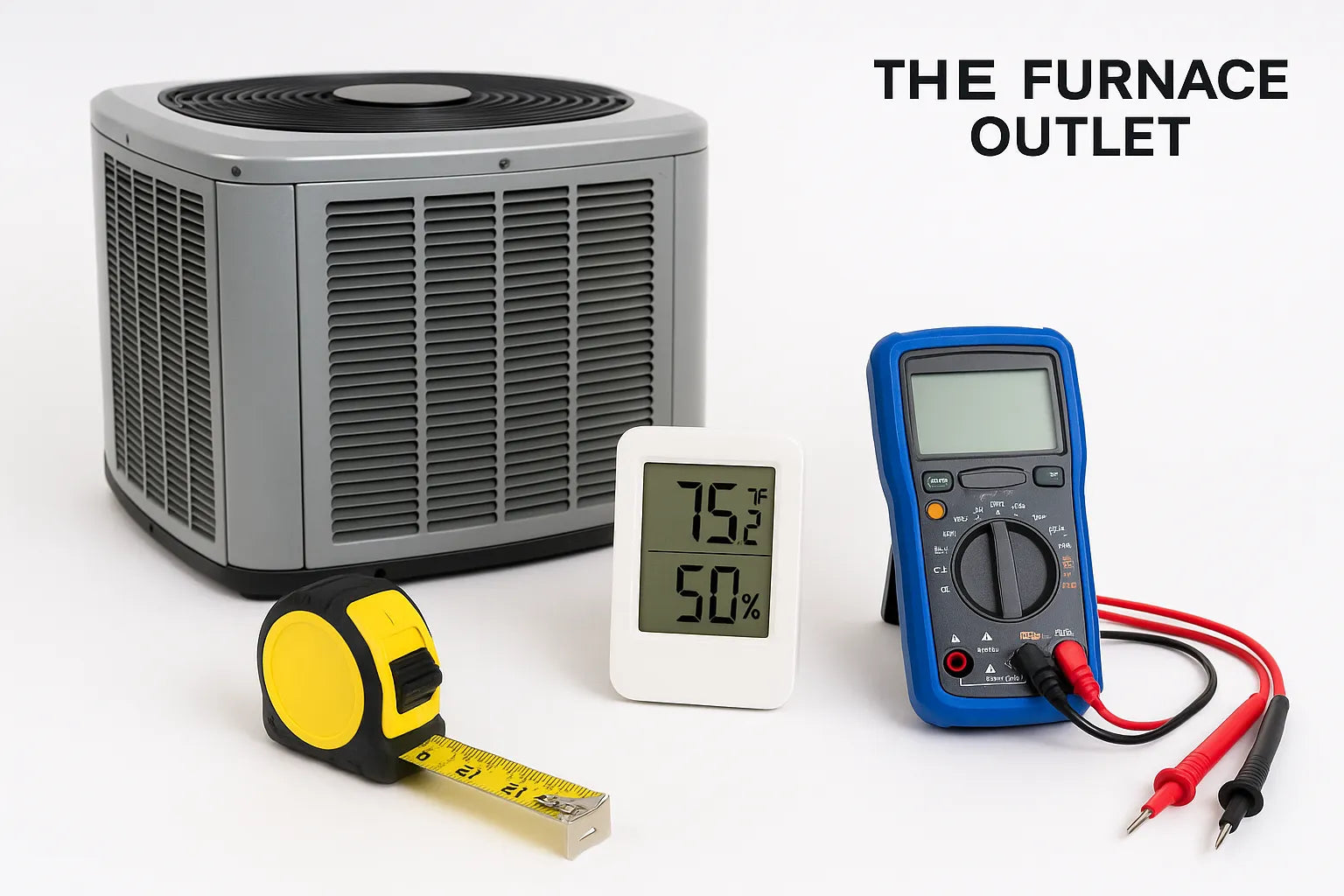Key Takeaways
-
Use Manual J for accurate AC sizing.
-
Measure rooms precisely; don’t guess.
-
Check temperature and humidity with proper tools.
-
Use a multimeter to test electrical capacity.
Why Getting AC Size Right Matters
Your air conditioner isn’t like a bigger TV—“more” doesn’t equal “better.” An oversized system cools the house so fast that it never runs long enough to remove sticky summer humidity. An undersized unit runs all day, driving up electric bills and wearing out parts early. New SEER2 rules for 2025 raise minimum efficiency to 13.4–14.3 SEER2, so a right‑sized unit is now both a comfort issue and a legal one. Accurate sizing also unlocks tax credits for high‑efficiency models and ensures even airflow in every room—no more “sauna” upstairs and “freezer” downstairs.
Manual J Load Calculation: The Gold Standard
Manual J software crunches dozens of variables—square footage, insulation R‑values, window U‑factors, shade trees, and even how many people live in the home. The result is a room‑by‑room BTU load that tells contractors exactly how many “tons” of cooling you need. Because Manual J simulates worst‑case outdoor temperatures, it guards against the guesswork of “400 sq ft per ton.”
Ready to upgrade? Explore SEER2-rated condensers.
Online Calculators: A Handy First Step
If you’re still shopping, an online BTU calculator offers a quick reality check. Enter your climate zone, home size, and insulation level to see whether you’re in the ballpark before paying for a pro load study. Our “HVAC Sizing Calculator Guide” walks you through each field and explains why climate zones matter more than ZIP codes. Remember: calculators assume average conditions, they’re great for narrowing choices, but always finish with Manual J for pinpoint accuracy.
Measuring Your Home: Tape & Laser Tools
Precise input equals precise output. A steel tape works for small rooms, but a laser distance measurer speeds up larger spaces and high ceilings without a ladder. Measure each room’s length, width, and height, then note window size and orientation. These numbers drop straight into your load worksheet or Manual J software, eliminating guesswork that can overshoot tonnage by 15 % or more.
For a printable checklist, download our AC Sizing Guide with Manual J Template.
Climate Checks: Thermometers & Psychrometers
Cooling load isn’t just about heat—it’s also about moisture. A digital thermometer tracks indoor and outdoor temperatures, while a psychrometer logs humidity. On muggy August days, the latent (moisture) load can double the sensible (temperature) load. Plugging measured 85 °F/70 % RH outdoor conditions into Manual J yields a unit that actually de‑humidifies, preventing mold and that “clammy” feeling.
For a quick humidity map by state, see our Climate Zone Map Guide.
Electrical Readiness: Using a Multimeter
Before ordering a 5‑ton condenser, verify that your service panel can feed it. A multimeter checks line voltage and confirms that the breaker lugs and wiring are in good shape. It also helps diagnose existing equipment—high resistance across a contactor coil can point to hidden electrical issues that would trip the new unit. A quick multimeter test today avoids a costly panel upgrade tomorrow and ensures your warranty stays valid.
Planning a new install? Shop complete residential systems.
Assessing Existing Systems: Gauges & Model Numbers
Replacing an older unit? A manifold gauge set reads refrigerant pressures, telling you whether the current system was ever correctly charged or is oversized and short‑cycling. Meanwhile, an online model‑number converter decodes tonnage from the data plate—helpful if the labeling is worn. Combine these readings with Manual J to decide if you can downsize, boosting efficiency without losing comfort.
Our “HVAC Sizing, Tonnage, and BTU Guide” shows real‑world examples after home renovations.
Inspecting Your Building Envelope for Hidden Heat Gain
Blueprints reveal wall layout, but insulation scanners and blower‑door tests expose leaks you can’t see. A poorly sealed attic can dump hundreds of extra BTUs into the Manual J load, forcing you to buy a larger, more expensive unit. Plugging those leaks first may let you drop half a ton of capacity, saving upfront cost and cutting annual energy use by double digits. Always update your load calc after adding insulation or new windows so the equipment matches the new reality.
Installing new equipment?Add the right line set.
Frequently Asked Questions
Q1. How many square feet does one ton of AC cool?
Rules of thumb say 400 sq ft, but that ignores climate and insulation. Always run a load calc; a tight, shaded home in Michigan may need only 250 sq ft per ton, while a leaky Florida home could need 500 sq ft.
Q2. Can I size my AC using only an online calculator?
Use calculators for a rough idea. Final selection should come from Manual J software or a professional HVAC estimator for true accuracy.
Q3. Does a higher SEER2 rating mean I can buy a smaller unit?
No. SEER2 measures efficiency, not capacity. You still need the BTU output that matches your load; a high‑SEER2 unit simply uses less electricity to deliver that cooling.
Q4. What happens if my unit is a little oversized?
Even “a little” oversizing short‑cycles the compressor, leaving humidity behind and shortening equipment life. Comfort suffers, energy use rises, and parts wear out faster.
Q5. How often should I redo a load calculation?
Redo your load calc whenever you add insulation, change windows, finish a basement, or remodel rooms. Any big change in square footage or envelope performance changes the cooling load.







